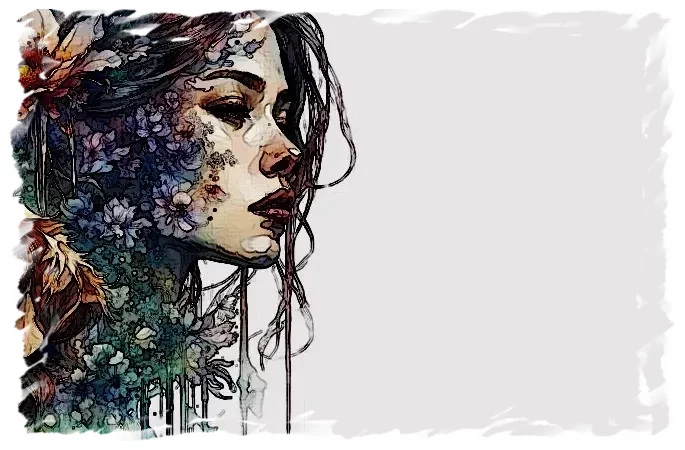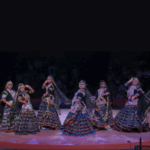“Akhila is sitting on a bench by the sea. She will sit here till the streetlights come on, and then she will walk back to the hotel, she decides. A short distance away, between her and the sea, is a young man leaning against his motorbike…A little later, Akhila sees him leave. She smiles. She has never known such power before.” (Ladies coupe, Anita Nair, p.269)
The years of growing up were spent in finding ways to belong and belonging in life. As I began reading about women in women’s writing, there emerged longing(s). Oftentimes, there was a longing for the sea, for travelling to the sea, for the winds and waves, and for its expanse. There have been encounters with desire and a pain in the in-articulation of what this desiring meant. As a confused young person, melancholy was often a constant companion and reading about Akhila travelling alone to the seas exposed oneself to possibilities in life.
I began reading women’s writing, especially from the Indian subcontinent, at the age of around 15, from Anita Nair’s story of ‘Akhila’. It wasn’t a canonical beginning nor a classic, one could say. It wasn’t mystery, romance, or poetry. However, it was about life in the every day, a woman’s life in her every day. This every day also meant encountering a domestic, intimate desire that carried many possibilities. In retrospect, I often feel it may have been quite a late start to getting introduced to women’s writing in India. I was growing up in a household which belonged to the post-partition generation and was witness to the 1984 anti-Sikh riots in Delhi. They had seen and lived with the trauma of loss and grief; therefore, finding stability through getting an education and finding work was always the most crucial. There was little space for art, music or writing, and a life was mostly lived with the mundane-ness and chronicity of an ache and anguish that often remained covered. For me, therefore, as a product of this inter-generational post-partition trauma, growing up listening to stories of a lost home and lost families, the loss was always felt closely, deeply. It was a pain that needed an articulation. Therefore, stories of every day, with desire and possibilities, always remained a window of an imagined life. Through these stories, I was not only making sense of a loss but also finding meanings of freedom that were going to be a negotiated struggle in the life to come.
My exposure to women’s writing and art happened very much on my own and often by chance encounters, accidents or perhaps luck. Whether such encounters happened through chancing upon a tattered Kamala Markandaya book ‘Nectar in a Sieve’ lying somewhere around in the house, from my mother’s borrowed collection, or finding an Anita Desai, a Manju Kapur, or a book/story on ‘blasphemy’, or short stories by Ambai (C.S. Lakshmi), in the school library. In these years of my life, I would just find corners to get lost in these stories of lives of women, which were mostly about struggles, restraints, inhibitions, but also aspirations and hopes. They were also about emotional landscapes that were layered and complex, giving a language to the loneliness that one encountered way too often. The walks that Lahiri writes about in discovering her ‘Whereabouts’ or the walk that Akhila makes at the sea in Kanyakumari, have been inscribed on the body as memories, written as journeys to be (re)discovered. My body has been accumulating these stories or finding an articulation of one’s own. It was these stories, these writers, that engaged with the familiarity of loneliness, which resided in the body, somehow keeping the boat afloat.
Anita Nair’s ‘Ladies coupe’ is about the intimate stories that women share with each other on a train journey. It is this shared journey that held contemplations on questions of being ‘good women’, good daughters, mothers, wives as well as that of desires, struggles, and aspirational joys. For Ambai too, journeys were significant in her writing, “a life threaded together by journeys” (Fish in a dwindling lake, Ambai, p.95). The journey was not just of a quest alone but also of moving forward and traveling along with one-self, with friends, with finding meanings. It made me reflective of my journey in life and the journeys that I wanted to make as a woman. Perhaps it has also been this ethos of the writing by women authors that made me reflect, ask questions, and embedding my early leanings on feminist ways of thinking and politics.
When I was reading Anita Nair, it was a time as a young person, I was also exploring my sexuality. I was trying to understand if my attraction to other women was okay to feel. I trudged along with a lonely self, in those years, struggling with these thoughts and feelings. It wasn’t something that was accessible to me in language or emotions. The body was felt more through shame, disgust and despise. Reading through Akhila’s story allowed me to see my body with desires, needs, fantasies. I could acknowledge the touch of the body with its bones, skin, flesh; with its form, shape, texture; with its darkness and fatness. In a similar register, Ambai’s stories of journeys, female friendships, bodies in labor, made me feel accepted in the body I was inhabiting beyond shame alone. It opened up the complexity of desiring another body that was close and similar to mine. Ambai (2003), elsewhere, also contemplates on the body inhabiting space(s) that is not just the physical space, but the space that is often the ground of struggle for women and women writers, the space that is silenced, the space of the body that is shamed and “ashamed to exist and exist fully”, the space that needs to be reclaimed. Meeting these thoughts, over the years has meant growing into, finding avenues for attempting to reclaim body, space(s), self.
I haven’t visited Anita Nair since the time I read it as a young person, however I have carried this memory of warmth all along. In retrospect, these memories of reading about women’s lives through women writers, have walked along, as desires, as reflections, as pieces of imaginations of journeys that I have slowly made in life and those that I also aspire to make. I am reminded here, of Derrida’s invocation of the ‘psychic’ in memory, something that is as if coded in the orality of language and history and can be understood even if people writing are not present. In a way, this helps me to think about how memory also is organized and how women’s writings invoke memories that carry and transfer psychic ways of desire and desiring, perhaps. In other words, the relationship of women’s writing and memory is also how it inscribes itself on the body, on the psychic. Gayatri Chakraborty Spivak also shares the idea of ‘critical intimacy’ about the intimate reality that one inhabits. One deconstructs only that which one inhabits intimately, “it speaks to you, you speak to it” (Spivak, 1993:60 in Kapoor, 2004:640). In that sense then, making sense of intimacy(ies) enables for a much deeper, embodied way of inhabiting, processing and absorbing the reality. Being with these women writers then, have also opened up ways we relate to the world and of be-ing in the world, in intimate ways.
Feminist literature too on women’s writing has been significant in underlining what and how they are written, how they talk about structures of power through the everyday lives, chores, travels, intimacies.
Women Writing in India represents a critical moment that requires us to strain against many earlier formations, but also one, we hope, that makes significant initial moves in developing an aesthetic that does not lessen discontinuity, dispossession, or marginality but dramatizes and clarifies it. It is an aesthetic that must undo the strict distinctions between the literary and the social text, abdicate the imperious functions it has been charged with over the last century and a half, and redesign itself to orchestrate contradictions and cherish the agonistic forms of insurgency and resistance. The promise it holds out is that of a critical practice that is by no means restricted to literature—or to the academy—but, in Gayatri Spivak’s phrasing, fills the “literary form with its connections to what is being read: history, political economy— the world.” (Tharu & Lalita (ed.), 1993: 39).
I bring in the feminist literature to talk about the influence of the women writers mentioned in this piece. In the encounters with these writers, and lives of women, I was feeling, touching, bringing closer home the struggles for freedom. A life lived with a myriad set of contradictions, restrictions, reprimands every day. At the same time connections made with a body which finds little space in the structural reality but what does it mean to accept it materially and in an embodied sense. The complexities and the presence of such stories offered an honest and earnest sense of living life as a woman in South Asia. Of accepting and sharing a sense of loss, grief and placing the landscape of life in a complex, political, personal reality. Of reminding oneself of the ethos of writing and reflecting on the everyday. In all this, one has also kept alive the caution and awareness of essentialising, of who becomes and gets written off as a ‘woman’ and what does it mean to understand woman in the experience and affect across a spectrum.
This piece may have to find an end, but endings are also openings and beginnings of other journeys carrying reminiscences and traces of the past.
As I wait for the ‘when’ to arrive…
When I will be able to have my own space, when I will be able to go to the sea, when I will be able to travel, an Akhila comes and shares a story of desire for her ex-lover, of a dream that she creates to live through her travels. An Ismat comes talks about her life, tells me about her survival because of her abrasiveness, sarcasm and of having lived a difficult yet fearless life while being called an ‘Incomplete woman’. A Pragya talks through her misophonia, her creative struggles and dreams as a woman; of her uncertainties, sadness, melancholy, her pains to feel stuck and un-stuck in a love that she is not able to let go, even in letting it go. With the intimate friendship between Kumud and Bimla of finding ‘fish in a dwindling lake’, waiting for the rains to come, I learn of sharing a life through the body’s certainty as well as body’s acceptance of everything. With Lahiri I walk, in and with her solitude, finding people in her whereabouts, getting to know them, her lovers, her city, her neighborhood, a mother, and through them finding her and perhaps myself in these whereabouts.
I stride with them, these stories, their lives, the struggles, and relationships intimate or something else. These touch in a texture that feels dream-like, a dream carrying the promise of home, love, hope, wander, abandon.
a musafir (wanderer) finding a way…
Bibliography
Nair, A. (2001). Ladies Coupe. A Novel in parts. Penguin books
Ambai. (2003). Two Novellas and a story. Translated by T Indra, Prema Seetharam, Uma Narayanan. Katha.
Ambai. (2012). Fish in the dwindling Lake. Translated by Lakshmi Holstrom. Penguin books.
Lahiri, J. (2021). Whereabouts. Penguin Random House. India
Chughtai, I. (2012). A life in Words: Memoirs. Translated by M. Asaduddin. Penguin books.
Bhagat, P. (2022). Swimming in our oceans. Zubaan
Chanda, G.S. (2008). Indian Women in the House of Fiction. Zubaan Academic.
Tharu, S. & Lalita, K. (eds.). (1993). Women Writing in India: 600 B.C to the Present; Volume 2: The Twentieth Century. New York: Feminist Press.
Kapoor, I. (2004). Hyper-Self-Reflexive Development? Spivak on Representing the Third World ‘Other’. Third World Quarterly, 25(4): 627-647.
Spivak, G. C. (1993). Outside In The Teaching Machine. New York: Routledge.
https://lareviewofbooks.org/article/critical-intimacy-interview-gayatri-chakravorty-spivak/



